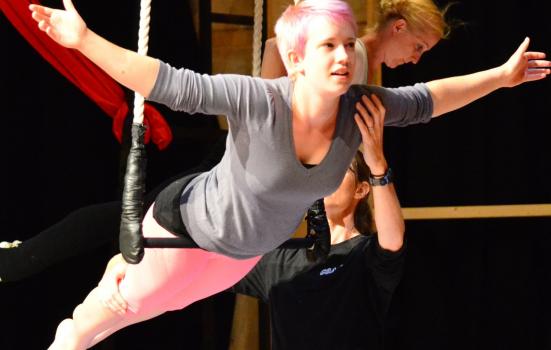Lindsey Butcher discusses the issues that emerging aerial dance artists face in an artform that itself is just emerging.

Aerial dance is a relatively new artform that has found its creative niche somewhere between the disciplines of dance and circus arts – which is exactly how I discovered it. While working as a dancer with Extemporary Dance Theatre, I was asked to learn a traditional circus rope spin for a new production. As there was no opportunity to learn these skills within the dance community or circus schools in existence at that time, I trained with circus company Ra-Ra Zoo and brought those skills back to the dance studio.
This opportunity revealed another universe for me. I loved this new discipline and trained with Ra-Ra Zoo whenever possible until eventually I joined them. My subsequent development into an aerial dance specialist derives from this twin foundation and I believe it is as true for emerging aerial artists now as it was then.
I am not convinced that creating a school of aerial dance is the answer
The one significant difference today is that there are several aerial dance companies (Upswing, Ockham’s Razor, Wired Aerial Theatre, All or Nothing, Fidget Feet and Scarabeus), each of which arrived at this practice via diverse routes. For us there was little ‘signposting’ along the way as to how to train, where and with whom, but these companies all now offer valuable training opportunities.
Within my own company, Gravity & Levity, the majority of our past and present company members are either young practitioners or artists experiencing and working with aerial dance for the first time. That means a lot of on-the-job training. What we are facing is the development of emerging artists in an artform that is itself still emerging.
There is no doubt that to grow future artists there is a very real need to provide structured professional training and guidance, which in turn feeds back into the creation of high-quality work. But I am not convinced that creating a school of aerial dance is the answer. Dance schools and circus schools already exist and an aerial dance school is in effect the community of companies that practise this hybrid art. I believe what is needed is a network of companies and activities to direct newcomers to the training opportunities on offer.
One such network is that of aerial dance festivals. The European Aerial Dance Festival (EADF) works in cooperation with sister festivals in Letterkenny in Ireland and La Baule in France to offer a European model of intensive courses. These are based on the original American Aerial Dance Festival in Colorado. These festivals run annually over three months from June to August and have grown rapidly over the last five years. Their intensive, immersive nature offers concentrated learning with internationally renowned tutors and a valuable opportunity for networking and sharing practice.
At the EADF this year in August we will offer more than 100 classes over seven days for beginners through to advanced professionals. Students can choose from up to six classes a day ranging from vertical dance to partnering in the air on trapeze and fabrics, to counterweight flying and aerial yoga. The aim is to support students technical learning and feed their creative curiosity while also providing them with practical guidance on specific conditioning and injury prevention, basic aerial rigging techniques, health and safety on a very personal and practical level, developing a sensibility towards their own health and longevity in their careers.
Whatever opportunities these festivals offer, they are concentrated in just three months in the summer. For the rest of the year emerging aerial dance artists have to find their training at the hands of experienced professionals in the aerial dance companies, so the more cohesive the network of companies, the easier it will be for artists to develop their skills and in so doing develop the artform.
Finally, an important aspect of the development of aerial dance is choreography. Training artists is one vital factor, but what kind of productions will these artists be training for? Finding choreographers who are willing to explore the added dimension of aerial dance will be crucial to broadening the scope of the artform.
Lindsey Butcher is Artistic Director of Gravity & Levity.
www.gravity-levity.net




